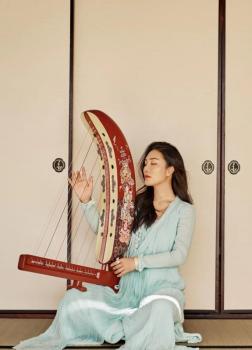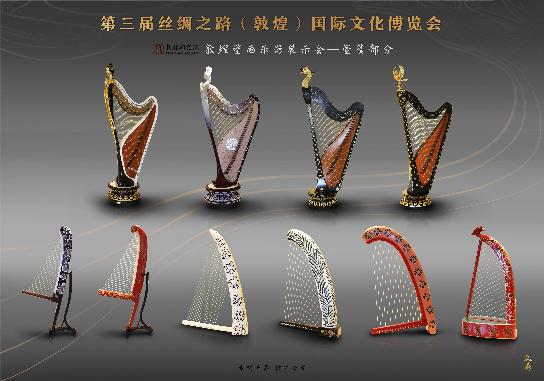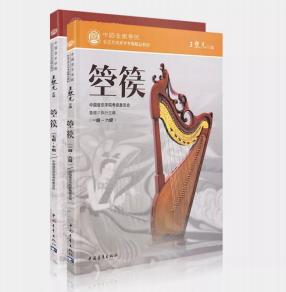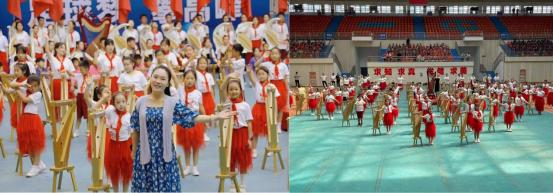Lu Lu: Adhering to the work of intangible cultural heritage is the persistence of every intangible inheritor of traditional culture
"Intangible cultural heritage work is first and foremost a perseverance. It is the adherence of the entire Chinese nation to traditional culture, and it is also the adherence of every intangible heritage inheritor to the intangible cultural heritage projects he is engaged in. As an intangible heritage inheritor, there must be a kind of tenure. Regardless of the seasons, I have the perseverance and perseverance to fight for the day and night; I must not be responsible for success and success, and I must be responsible for success, so as to truly inherit the Chinese intangible heritage.” In 2022, “Cultural and Natural Heritage On the occasion of the "Day", Konghou performer and inheritor of the intangible cultural heritage Konghou Lu Lu summed up his own history and experience in inheriting and promoting the art of Konghou. Lu Lu is a young literary and artistic worker born in the 1985s. He is currently teaching at the China Conservatory of Music. He is employed as the vice chairman of the Konghou Professional Committee of the Chinese National Orchestra Society and a member of the National Expert Committee of the China Musical Instrument Association. He serves as Tianjin University, Southwest University and Henan Normal University. University, Hainan University and many other colleges and universities visiting professor. Although very young, Lu Lu has devoted himself to the art of Konghou for 20 years since the "Fifteen Bullets of Konghou".

Lu Lu
As an inheritor of the Konghou, I think the most important thing is to find the roots of a once-lost musical instrument like the Konghou. Find the root, it is no longer duckweed. So I went to Qiemo, Xinjiang, and I saw the Konghou musical instrument that had been dormant for 2,700 years..." When talking about his work on the intangible cultural heritage, "the journey to find the roots of Konghou on the Silk Road" was first mentioned by Lu Lu. It was in 2015. She crossed the Taklimakan Desert and came to the small town in Xinjiang, Qiemo. Here, an ancient vertical konghou object dating back 2,700 years was unearthed, which is one of the oldest existing stringed instruments in China. In Qiemo, Lu Lu has carried out a series of work, including signing a strategic cooperation agreement with the Qiemo County Government of Xinjiang, opening the country's first public welfare Konghou teaching base in Qiemo, holding seminars with scholars in Xinjiang, and leading the growing inheritors to hold the world's first teaching base. He gave a desert Konghou concert, led Qimo Konghou children’s inheritors to record the special theme of Konghou chasing dreams in Zhejiang Satellite TV’s “China Dream Show”, held a desert Konghou starry sky concert, etc. Over the years, Lu Lu has traveled to Xinjiang more than ten times, and the total itinerary more than ten thousand miles.

Silk Road Konghou Root-seeking Journey
"If the root of Konghou is in the Silk Road, then the soul is in the Central Plains. This may seem difficult to understand, but it is created by the unique historical development of Konghou." Lu Lu explained the history of Konghou. As early as the Spring and Autumn Period, the Konghou was born in the Yellow River Basin of the Central Plains. At that time, the shape of the Konghou was similar to the qin and se; later in the Eastern Han Dynasty, the bow-shaped vertical musical instrument similar to the Konghou unearthed in Xinjiang was introduced to the Central Plains from the Silk Road, and was also named Konghou's name. Later, in order to distinguish them, people called these two kinds of konghou as lying konghou and vertical konghou, together with the phoenix-headed konghou introduced in the Eastern Jin Dynasty, which together constituted the three forms of ancient konghou. Since the Central Plains was the political, cultural and economic center of China for a long time in ancient times, all three kinds of Konghou developed in the Central Plains.

Ancient Reclining Konghou, Vertical Konghou, Phoenix-headed Konghou
Lu Lu was born on the banks of the Yellow River, and his hometown is Xinxiang City, Henan Province, which is exactly one of the important birthplaces of the ancient Konghou. In 2018, Lu Lu established the "Jiuding Konghou Cultural, Artistic and Creative Industry Park" in Xinxiang Economic and Technological Development Zone, launched the "World Konghou Historical Fundamental Resource Reorganization and Protection Project", and concentrated the work results in Konghoufei in the park. Material Cultural Heritage Museum - "Jiuding Konghou Museum".

Jiuding Konghou Cultural Art and Creative Industry Park
This is a huge project. In the Chinese part, Lu Lu and his team rescued more than 330 historical images of Konghou from murals, paintings, ancient books and other sources in Chinese history, and successively restored and imitated them into real objects. Exhibiting in museums can revitalize intangible cultural heritage, make cultural relics go out of murals, bring history into reality, and present the cultural stories behind musical instruments. In the world part, more than 1,000 historical images related to pan-konghou musical instruments from more than 60 foreign countries have been sorted out, and the work of physical restoration and imitation has also been carried out, linking the world intangible cultural heritage with Chinese intangible cultural heritage. Different, beautiful and common" presentation.

Jiuding Konghou Museum Main Hall (Part)
"The museum presents not only musical instruments, but also the rich and splendid Konghou culture." In order to present the Konghou culture in a more systematic and more dimensional way, Lu Lu led the team to draw a map of China's Konghou, a map of the world's Konghou, and the Yellow River Basin. Konghou Map, Grand Canal Basin Konghou Map, Silk Road Konghou Map, etc., to present the spatial axis of Konghou development. At the same time, a 5,000-year historical chronology of Konghou in the world is also drawn to present the time axis of the development of Konghou. In addition, the museum also has a literature resource library: in the literature section, more than 600 poems related to Konghou in ancient my country have been sorted out, and calligraphers are invited to write and present them in the form of calligraphy works; in the literature In the section, more than 5,000 historical records related to the Konghou in ancient Chinese books have been sorted out, and at the same time, the Chinese volume and the second volume of the World Volume of the World Konghou Intangible Heritage Atlas have also been compiled, as supporting reading materials for the Jiuding Konghou Museum. Such a systematic cultural project with Konghou as the carrier, including literature, philology, music, calligraphy, painting and other factors, shows the cultural charm of Konghou in an all-round and three-dimensional manner. Today, "Jiuding Konghou Cultural Art and Creative Industry Park" and "Jiuding Konghou Museum" have been selected as Henan Province Intangible Heritage Research Base, Henan Province Cultural Industry Demonstration Base, and selected as a typical case of the "Three Belts Construction" of the Grand Canal of the National Development and Reform Commission.

Lu Lu and his team and the Dunhuang Research Institute jointly restored the imitation and innovative Konghou to land at the 3rd Silk Road Cultural Expo
As a shining cultural business card, "Jiuding Konghou Museum" has won the attention and support of Party committees and government departments at all levels, including Henan Provincial Party Committee and Provincial Government, Xinxiang Municipal Party Committee and Municipal Government, Xinxiang Economic Development Zone District Party Committee and District Government. Today, as one of the birthplaces of Konghou, Xinxiang City has deeply explored the historical background, closely combined with the national intangible cultural heritage policy, and is making every effort to create the urban cultural name card of "Hometown of Konghou", and has made great efforts in the protection, inheritance and utilization of urban intangible cultural heritage resources. Beneficial exploration and in-depth practice have become a typical case of the government, enterprises, and intangible cultural heritage being closely linked to jointly protect intangible cultural heritage, inherit intangible cultural heritage, and utilize intangible cultural heritage.

National Civilized City·Xinxiang "Konghou" Landmark
This year's Heritage Day intangible cultural heritage activities are based on the theme of "connecting modern life and blooming charming brilliance", with the slogans of "people's intangible cultural heritage shared by the people", "stimulating the vitality of intangible cultural heritage to create a better life", and "rejuvenating the intangible cultural heritage in rural areas" as the slogan. The two key words "era" and "people". According to Lu Lu's analysis, the loss and revival of Konghou art are also closely related to these two keywords. The reason why the Konghou was lost in the Qing Dynasty was that the court did not pay attention to it in the early Qing Dynasty, and excluded the Konghou, which had always been a court musical instrument from the Sui and Tang Dynasties to the Ming Dynasty. However, it has not been able to take root in the soil of the people. This is the reason for the "people" level. Today, however, with the rejuvenation of the Chinese nation and the country's emphasis on traditional culture and intangible cultural heritage, traditional national instrumental music such as Konghou has ushered in its best era. Especially the Konghou, because it was lost, it has a beautiful meaning of revival. Lu Lu said excitedly that by 2022, the situation of the revival of Konghou has become very clear. The China Conservatory of Music's Konghou grading test has been fully launched nationwide this year, and a large number of Konghou piano children and even adults from all over the country have applied for the test; The large-scale professional exhibitions and competitions organized by the Ministry of Tourism, the Global Music Education Alliance, the China National Orchestra Society and other units have included Konghou as subjects. Children's cultural self-confidence, improve their aesthetic quality. At the same time, the people will also become the strongest backing for the continuous and vigorous development of this art.

Chinese Conservatory of Music Konghou grading test textbook edited by Lu Lu
"When inheriting, protecting and utilizing the art of intangible cultural heritage, our work method is not single, but systematically carried out in the four fields of "culture + art + industry + education". For education communication and artistic interpretation, The capital, Beijing, undoubtedly has an inherent advantage.” As a professional teacher of Konghou in the China Conservatory of Music, Lu Lu is the executive editor of the 1-10 and all-level Konghou grading examination materials of the China Conservatory of Music, and has formulated the examination standards. In addition, in order to promote the cultivation of Konghou inheritors, she also established an education base in Beijing, and created the Chinese Konghou social teacher education and development system. So far, she has trained more than 600 Konghou inheritors from all over the country. At the same time, she is committed to improving the practice frequency and performance level of Konghou art. She has performed more than 100 times on large-scale stages such as national international conferences, CCTV and various David TVs, as well as individual concerts with the inheritors she has cultivated, which has promoted the development of Konghou art. widely disseminated.

Bringing the 23 Konghou heirs he has cultivated to the stage at the 2020 Chinese Federation of Literary and Art Circles Spring Festival Gala
In addition to the above, Lu Lu also led the team to continue to explore, in order to keep up with the pace of the times. She believes that in carrying out intangible cultural heritage work, it is necessary to insist on creative transformation and innovative development, and find the connection point between traditional culture and modern life. Therefore, she has been seeking a modern expression of traditional culture, using the Internet to promote the inheritance and promotion of non-genetic inheritance through online fan communities, and the creation of personal IPs. At the same time, she is also obsessed with public welfare. For example, in Qiemo County, Xinjiang, in 2015, she and the local government jointly established the country's first Konghou public welfare teaching base; in her hometown, Xinxiang, she began to promote Konghou public welfare into the campus in 2019 and integrate it into national education. More than 100 pieces of Konghou musical instruments have been installed in nine primary and secondary schools, and nine Konghou classrooms have been built. So far, more than 1,000 children's Konghou inheritors have been trained.

Hundreds of young pioneers who brought intangible cultural heritage Konghou into the campus for public welfare training performed at the opening ceremony of the Henan "Governor's Cup" football match
 渝公网安备 50010702504639号
渝公网安备 50010702504639号